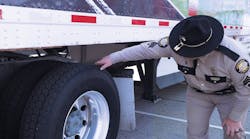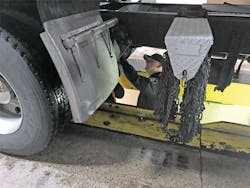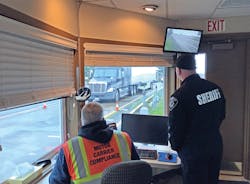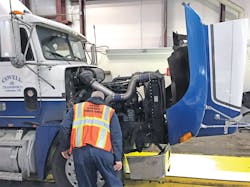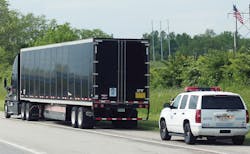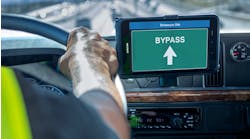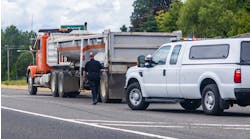It can happen if a truck gets pulled over or at a weigh station a driver must go through. It might take place as part of a check at a truck depot. The roadside inspection is probably one of a truck driver’s — and fleet’s — least favorite things. It’s a little like getting pulled aside for an enhanced search of some kind in the airport security line; no one relishes the thought, especially when they’re just trying to get to that gate as quickly as possible, as the case often is.
That’s not all that different than a truck driver trying to pick up or deliver that next load. The roadside inspection is a necessary and important element of commercial vehicle operation for keeping America’s roadways safe, but it can hold up drivers and — should it turn up some inspection problem that was overlooked — it can be a good way to have bad day real fast.
We’ve pulled together advice on what can help make those roadside checks go as quickly and smoothly as possible, both for the driver and the officer or official performing the inspection. It’s best for all parties involved when these inspections are as expeditious and uneventful as possible.
But before we roll through all the various things to keep in mind, there’s a simpler piece of advice: The best way to breeze through a roadside inspection or avoid one altogether is for the truck driver and fleet to be doing their jobs as they should.
Be sure the commercial vehicle is kept up on its maintenance and is in good repair. The driver must have proper certifications and licensure and be operating according to the federal Hours of Service (HOS) regulations, as applicable. Drivers must perform proper pre- and post-trip inspections and must operate the commercial vehicle as attentively and as safely as possible — again, as professional drivers, simply doing the job they’ve been trained to do.
That said, there are many complex requirements surrounding the operation of a commercial vehicle today, and if overlooked, it could land a driver and truck out of service. First and foremost of those is the acute focus at present on electronic logging devices (ELDs) and Hours of Service compliance, and it’s likely to lead to plenty of “gotchas” this year.
It’s not really anything new. Every year, HOS citations make up a large portion of violations that place commercial vehicles out of service. But with full enforcement of the ELD mandate now in effect as of April 1, it’s alphabet soup time: ELDs and HOS are likely the first items on the checklist of any officer or inspector checking out a truck.
Adding to that, the Commercial Vehicle Safety Alliance’s upcoming International Roadcheck inspection blitz June 5-7 will spotlight HOS compliance. Our first several tips for roadside inspections accordingly are in that vein.
Keep in mind, though, that all that will be in addition to the usual suspects with commercial vehicle violations—common deficiencies with brakes, lights, and tires that have tripped up many a truck driver. Elements of the inspection relating to the vehicle itself can involve a thorough examination of frame, suspension, exhaust systems, driveline, cargo, steering, and more.
1. Drivers must be sure they’re correctly operating according to HOS rules.
Certainly, an element of any roadside inspection—and very possibly a trigger for a more thorough look at the truck by an officer if things don’t go well—will be the ELD and its proper or improper use, if that’s what’s in the truck. But not so fast.
While much of the discussion in trucking has centered on ELDs, the real issue is what ELDs enforce, namely the federal HOS rules. Now is the time to brush up and be sure drivers understand and are operating according to those requirements. ELD makers have gotten feedback about drivers having problems using the devices because they weren’t actually using the HOS rules correctly, and it’s leading to citations and violations.
“You have to talk to a driver and the fleet and really understand if they have been using Hours of Service correctly in logging their record of duty status,” noted Sid Nair, director of transportation and compliance at Teletrac Navman, a provider of fleet and asset management products as well as an ELD. “It’s not just ELDs but how they were using the Hours of Service in the past three years, five years, 10 years,” he told Fleet Owner. “Was that actually legally the right way to do it?
“I’ve heard many drivers say, ‘Hey, I can’t pause my hours once I start on-duty time.’ Well, you couldn’t pause your hours before, either,” he continued. “I think there’s a lot of confusion because of the fact that ELDs are enforcing the Hours of Service now. The Hours of Service have obviously been around, and some people have been consciously or unconsciously violating them. But now they’re being forced to have to reconcile with them electronically.”
2. Know what device you have for electronic logs, if you’re required to use one.
There is still a great deal of confusion in the trucking industry, even among the well-informed, concerning ELDs and their predecessors. Terms for them are often used incorrectly or interchangeably. But in a roadside inspection, calling something the wrong name can make a huge difference, so drivers will want to get this one right.
“The number-one piece of advice I have is to make sure your drivers know what they have,” said Joe DeLorenzo, director of the Federal Motor Carrier Safety Administration’s (FMCSA) Office of Compliance and Enforcement.
That’s easier said than done—there’s credible cause for the confusion. Prior to the ELD mandate and specific guidelines that created ELDs, devices that kept electronic driver logs were called automatic onboard recording devices, or AOBRDs. Another term you might hear — electronic onboard recorders, or EOBRs—was a nonstarter and no one should be using it. That term came from an earlier effort by FMCSA that fizzled out.
But at this point, commercial drivers should be using a certified ELD or an AOBRD, if they had one in use before the ELD mandate deadline of Dec. 18, 2017. The older AOBRDs can be used through Dec. 17, 2019. The trouble is, there are big differences between ELDs and AOBRDs that could cause a driver headaches during an inspection if misidentified.
The main thing is that AOBRDs are not required to have the specific ways of transferring data that ELDs are, explained Teletrac’s Nair. While ELDs are required to be able to be handed physically to an officer or transfer data by web service, email, Bluetooth connectivity, or USB, there were no such requirements for AOBRDs. Further, the type of data file an ELD transfers to an officer or inspector is encrypted and very specific.
So what happens if an officer were to ask a driver using an AOBRD, “Are you using electronic logs?” The driver may well respond in the affirmative, but then would not be able to transfer data to the officer as with an ELD, possibly leading to a malfunction citation if that’s what the inspector believes the driver has.
“I get calls on that every day. I’ve seen citations come through because a driver couldn’t electronically transfer logs,” Nair said. “And drivers have said, ‘But I have an ELD, and I couldn’t do it.’ I tell them, ‘No, you have an AOBRD—it’s the older device—and you were technically in compliance and shouldn’t have gotten a citation.’”
To assist in this regard, he noted, Teletrac has been issuing AOBRD users letters to keep in the truck, and some fleets have been doing the same. “We’ve proactively sent letters to our customers to keep in the glove box so drivers can hand them to an officer to explain that they’re actually using an AOBRD,” Nair said.
ELD users, meanwhile, must keep very particular documentation in the truck. FMCSA’s DeLorenzo spelled that out recently in a discussion with truck drivers. “On board, drivers are required to have the [ELD] user’s manual, which can be paper or electronic. There has to be an instruction sheet for data transfer, and you have to have an ELD malfunction instruction sheet,” he said. “And any supporting documents in the driver’s possession must be provided to the safety official upon request.”
Also, in case of ELD malfunction, drivers must have eight days’ worth of paper logs to use.
3. Get educated on how to use your ELD or be sure you know how your AOBRD works.
Beyond all that potential confusion and misidentification surrounding driver logs, it only makes sense to make sure drivers know how to use whatever device they have. You don’t want to be fumbling through things when an officer or inspector is asking for information.
“One tip I would give is education, education, education,” Nair emphasized. For trucks with ELDs, he recommends that fleets designate and establish an “ELD champion”—someone familiar with all the new rules—if they don’t have one already. That might be a dispatcher or fleet manager. Whoever it is, drivers should know exactly who to call if they run into a problem in an inspection or stop out on the road.
And drivers should be sure to read the instruction manual. “Familiarize yourself with the product. Understand the basic things. How do you log in? How do you take care of your logs? How do you ensure that you have your manifest information in correctly?” Nair explained. “Because web transfer isn’t going to work if you don’t have your ELD manifest information in correctly.”
4. Perform a proper pre-trip inspection.
If they’ve done their homework regarding electronic logs, the next thing drivers can do that will go a long way toward ensuring passed inspections comes down to the pre-trip inspections they perform themselves. Fleet Owner caught up with Sgt. Jason Morris with the Kentucky State Police’s Commercial Vehicle Enforcement Division for some advice—from its location at the center-east of the country in Kentucky, the division sees quite a variety of long-haul trucking rolling through to points north and south and off to the west.
“A driver should do a good, proper pre-trip inspection, actually give it time. Give the truck a chance to air up and listen for those air leaks,” Morris said. “Check the tires. Make sure you don’t have something that’s about to fall off.
“If it’s a non-sealed van trailer or other trailer you can access, check your load securement—make sure something hasn’t shifted,” he continued. “Check to make sure your tires are adequately inflated, and make sure they’ve got the proper tread depth. Make sure you don’t have exhaust leaks, and make sure your lights are working.”
Also, he added, be sure the truck’s windshield is clean. It’s a matter of safety for the driver’s visibility and can speak volumes to an officer—it could even mean getting inspected or not.
“Something as simple as cleaning the windshield will tell me, ‘Did the driver do a proper pre-trip?’” Morris noted. “Because if he didn’t even take the time to clean his windshield off that morning, then I know he probably hasn’t taken the time to update his logs, whether he’s running paper logs or using an ELD system. And he probably hasn’t taken the time to do a good walk-around on his truck.”
5. Drive safely and legally.
Another good way to avoid inspection headaches is to not get pulled over. You essentially want to be invisible to law enforcement officers. And as noted earlier, that’s actually not all that difficult: just straighten up and fly right.
Enforcement officers will be keeping an eye out for any commercial truck, but what drivers do inside the cab could make a difference. “When you’re operating, make sure you stay off that cell phone,” Morris said, unless using a hands-free system or earpiece or making an emergency call. Holding the phone itself is okay when dialing a number or checking GPS directions—just be sure to enter your destination before driving.
“That and seat belts right now are a big push with the Federal Motor Carrier Safety Administration with the Road to Zero [campaign to end roadway fatalities],” Morris noted. “And when you wear your seat belt, make sure you’ve got the shoulder strap across your chest and have the lap belt properly secured. Don’t wear it loose hanging down over your arm.”
Again, it’s just common sense, but driving legally and safely is going to help drivers stay out of trouble and avoid stops. Don’t speed and obey traffic signals and road signs. Officers are looking for something going on out of the ordinary.
“We know there are a lot of distractions that go on out there, so the more that you can work to prevent those distractions, the better,” Morris emphasized. “Make sure that you’re doing the job at hand, which is driving—that’s why you’re called a professional driver.”
On a final note, truck drivers shouldn’t feel singled out by law enforcement, although sometimes it may feel that way. Roadside inspections are just one part of the larger effort to achieve safe roadways. “Our title is ‘Commercial Vehicle Enforcement,’ but we don’t just handle commercial vehicles,” Morris noted. “If we see a car out there that cuts a truck off, we’re going to address that car. We’re going to stop them and make sure they realize that, essentially, they just cut off an 80,000-lb. bomb, because if they’d suddenly stopped, that’s about the equivalent devastation that could’ve occurred.”
“So we’re not only looking at the commercial side, we’re looking for total safety on the roadway,” Morris said. “That’s what we’re trying to enforce out there.”
